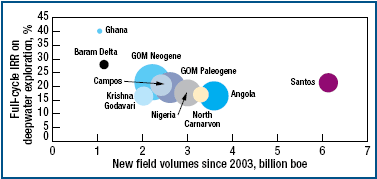September 2008
Columns
Deepwater Statistics
In recent years, deepwater exploration has had to face a fresh set of challenges that are very different from the hurdles that faced deepwater pioneers in the 1990s. Many of these challenges have been driven by the sharp rise in oil prices in this period, and in this article we look at full-cycle returns in key deepwater basins under a $100/bbl long-term Brent oil price assumption.
The chart shows a comparison of deepwater volumes discovered and the full-cycle economic returns generated by these discoveries. The bubble sizes are based on the relative exploration spend in each basin.
Under this price outlook, deepwater returns average around 20%-sufficient to keep deepwater exploration attractive despite the well-documented increases in drilling costs over the period. The highest returns have been in basins with very localized discoveries. In Ghana, Jubilee Field is still being appraised, but in the Baram Delta the Kikeh development came onstream quickly and cheaply.
- Advancing offshore decarbonization through electrification of FPSOs (March 2024)
- Subsea technology- Corrosion monitoring: From failure to success (February 2024)
- Driving MPD adoption with performance-enhancing technologies (January 2024)
- Digital transformation: A breakthrough year for digitalization in the offshore sector (January 2024)
- Offshore technology: Platform design: Is the next generation of offshore platforms changing offshore energy? (December 2023)
- 2024: A policy crossroads for American offshore energy (December 2023)



